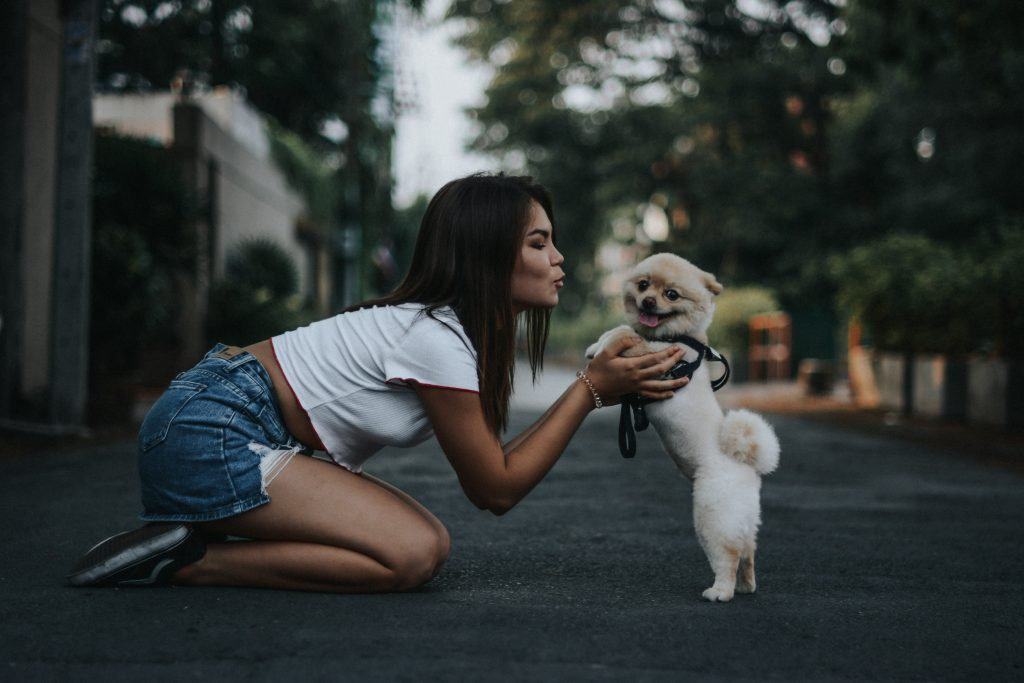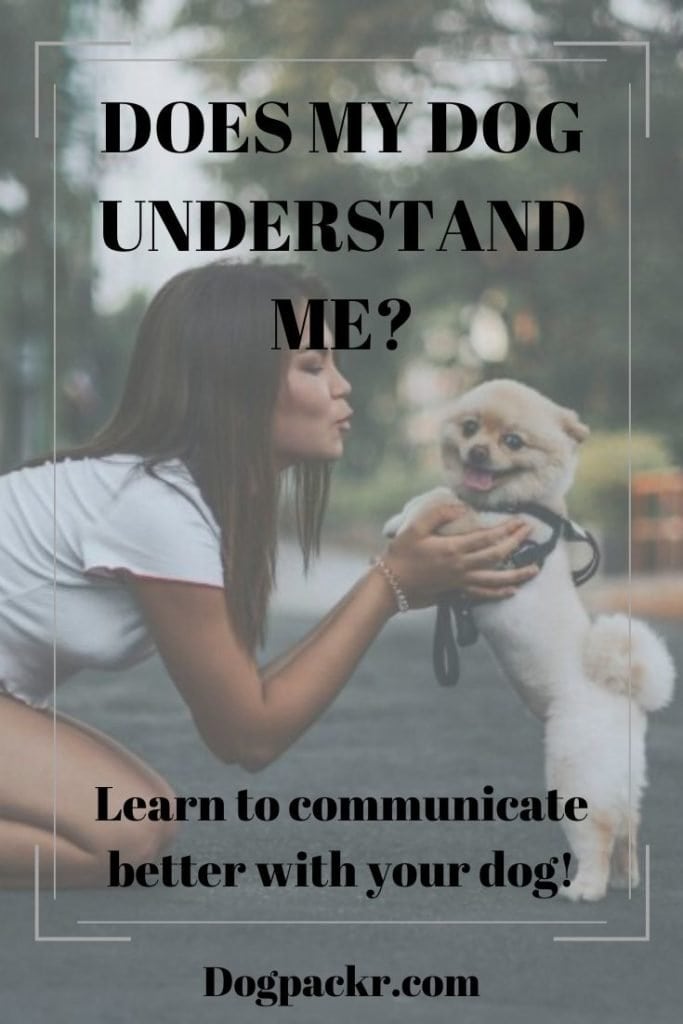
Did you ever get the feeling that your dog doesn’t understand you at all? Particularly when he just seems to have forgotten all orders ever taught? You’re not the only one! Every dog owner will encounter a situation sooner or later, where he or she’s wondering: does my dog really understand me?
And that has a good reason. Dogs can’t speak and while they can understand a surprisingly big variety of words, it’s not their natural method of communication.
Dogs mostly communicate non-verbally. Only the trained eye can see the communicational meaning of a movement, a certain position or a glance given by a dog.
Hence the easiest way to communicate with your pooch is to also do it in a non-verbal manner. In my opinion, it’s particularly important to understand how a small dog understands our body language. Because of their size, we tend to treat them with great affection like a baby or even a plush toy. However, your pup will probably understand your actions very differently.
In this post I will show you how your pup deciphers your body language and how you can teach him orders with non-verbal signs.
Table of Contents
Dog communication 101
Dogs do use some vocal communication, such as barking, howling or growling. But that is the exception. Most of canine communication is done with body language or even scent cues. Most signs are so subtle that we can’t see or recognize them. This could be a facial expression or even a slightly different standing position towards another dog. And of course, all the scent cues are virtually unreadable for us.
Here are some of the basic body language signs that we can understand and their meaning. They always have to be read in context with each other.
Position of certain body parts
You can especially observe different positions of a dog’s ears, tail or head/face. Or even in which way he’s approaching another dog or the position in which he’s standing compared to another dog.
Facial expressions
Yawning: while it can definitely just mean that your dog is tired (when he’s relaxed and just woke up from a nap, e.g.), it is usually one of many calming signs. If the yawning is very stiff and sort of shivering, it signals stress.
Baring of teeth: The most obvious facial expression is the baring of a dog’s teeth. This generally means an aggressive warning sign, usually accompanied by growling. It could be translated into something like “Back off, you’ve gone too far! If you’re approaching any further, I might bite you!” This is also accompanied by excessive tongue flicking.
Lip licking: this can have a number of meanings, depending on the context. In most cases, it’s a deescalating, calming sign.
Ears
A dog’s ears also play an important role in communication. Regardless of the shape, size or type of a dog’s ears, you can learn to read the signs. Even floppy ears can be relaxed, put back or stiffly put up. I can see this with Baloo very clearly.
Relaxed, rather pulled back ears in combination with a relaxed body and a fast wagging tail means a happy relaxed dog.
Put up ears in combination with a stiff body and a slowly high wagging tail means an alert, excited dog.
Pulled back, flattened ears with a crouched body and a slowly low wagging tail means anxiety that could turn into aggression if the dog is further approaching.

Tail
A dog’s tail can also tell us a lot about his current state of mind.
A tail tucked between a dog’s legs means he’s afraid. Dogs do this in order to protect there strongest scenting areas, anal area and genitals. This way they try to prevent the enemy to smell their fear.
A wagging tail doesn’t necessarily mean a happy dog. You always have to look at the tail in context with the whole body. A wagging tail in a high position with a stiff body means he’s excited. In this case the tail will wag slowly. If the tail wags slowly in a low position your pup is wary or anxious, particularly if his posture is also crouched. A fast wagging tail, where you can basically see the whole dog wagging with it, is the classically known sign of happiness.
Position towards another dog/posture
In dog language, it is very rude and even a threat to approach a dog directly from the front. A friendly approach is rather in a half circle way, from an angle. Also you can mostly see how a dog feels by looking at his posture, as already mentioned under “Ears” and “Tail”.
This video shows some very well described situations of dog communicating with each other.
So how does my dog understand me?
First of all, we need to understand, how a dog tries to understand us.
How your dog deciphers you
A dog is a very good observer. He will study you very closely and will soon interpret even the smallest body movements in a certain way.
The most obvious is when you’re angry or excited. When you’re angry with your dog, you get tense and your voice will rise. This might frighten your dog and lead him to look timid or sheepish. Humans tend to interpret this as the dog being ashamed. But he really is afraid of you! And if he hasn’t been caught in flagranti, he has no idea what you’re angry at.
When you’re excited, your body moves more and your voice usually has a higher tone. This will also excite your dog who thinks that there is something amazing, really exciting going on. This can usually lead to jumping and playful nibbling.
Very important to take note as a small dog owner is the way we approach our dog. We tend to stand over the dog, bend over him and pet him on his head. Now in dog language this is is a really rude and respectless approach. It’s also really scary! Just imagine a giant, 10 times your size, would bend over you and pet your head. Heeeeeelp!!!
It is much better to squat next to a small pooch and pet him on the side of his head, he will thank you for this.
How to train your dog verbally
It’s definitely possible to only train your dog verbally. A dog can learn the meaning of about 160 words on average. Very intelligent breeds can learn much more. What’s also very important to note is that your pooch doesn’t know any word when he’s born, not even his name. So you can literally teach your dog any word. He just has to learn to make the connection between a certain word and an action. So you could also teach your pup the word “table” to make him sit. It really doesn’t matter.
The tone of your voice is also very important. You can sort of lead his energy with the tone of your voice. High-pitched and excited tones can excite your furry friend, while a deep, calm voice can calm him down.
So you can train your pupper to only learn verbal commands. However, I still recommend to learn at least the Dog communication 101. It makes living with your pup just so much easier if you understand his way of communicating and also how he understands you!
How to train your dog non-verbally
You can make use of a dog’s non-verbal communication by using hand or body signals to teach him commands. For obedience training it’s very common to use hand signals. I will soon make a video to show you exactly what I mean.
However, obedience training usually consists of the use of verbal and non-verbal orders. I will come to that in a minute.
There are certain things that I like to communicate in a fully non-verbal manner, though. I have made the observation that Baloo really does understand it better that way.

How to communicate like a dog
So here are a few examples of how you can communicate non-verbally, like a dog:
This is mine
That’s a very easy one to actually communicate to your dog. However, it can be difficult to be trained if your dog is very possessive.
So what dogs do to show other dogs that something belongs to them, is to put their paw on it. You can just imitate this by putting your hand or foot on something that you want. If your pup doesn’t even let you touch the thing you can also just stand close and kind of annoy him. Keep getting closer to the thing you want. You can try it with a sturdy shoe on first, in case your dog really doesn’t want to give you the thing and might want to bite you. Since you are the pack leader, it is very important that you can have anything at any time you choose. If you let your pup choose when he can have what, then he’s the boss!
Attention: only do this if you know your dog well. I can “read” Baloo pretty well in what kind of mood he is. Also, he’s generally a very friendly dog. I’ve never seen any kind of aggression in him. So that makes it very easy to communicate this way. If your dog is more reactive, you might have to take a slower approach.
Correction
What worked really well for me in terms of correction is to look at Baloo in a very calm but very strong way. I signal him that I’m not happy with what he’s been doing (e.g. I told him to stay in his bed and he got up again).
So I just look at him, stand in an upright, confident position and wait. Usually, I can see calming signals such as sneezing or licking his lips after 2 seconds and he turns around. If he doesn’t move, I start to stare at him, signaling him, I am really not happy with what he’s doing. Also, I bow forward a tiny little bit to strengthen my gaze. This definitely always works and I don’t have to say anything. If he does it again, I also growl in addition to the gaze.
As soon as he’s doing what I want, I ease my position (don’t reward him, it’s a correction) and go about whatever I was doing.
Verbal and non-verbal training
What I like best is to train Baloo in a verbal and non-verbal manner at the same time. So whenever I teach him a new command or trick, I will teach him a word and a sign at the same time. This way I can later choose to use the verbal or non-verbal sign, depending on the situation. Mostly, I use both at the same time. This way it’s super clear for your pupper what you mean.
Benefits of non-verbal communication
With non-verbal communication, your dog will understand you much better. Obviously, non-verbal communication is much calmer. Of course, you can also have a very aggressive attitude without saying a word. But I think it’s easier to stay calm if you’re not using any words.
I hope I could give you some indications on how dogs communicate, how you can understand him better and how to actually make him understand you. If you still have any questions, leave a comment, I’ll give my best to answer it =)
*Disclosure: This post may contain affiliate links, meaning, I get a commission if you decide to make a purchase through one of my links, at no cost to you.

